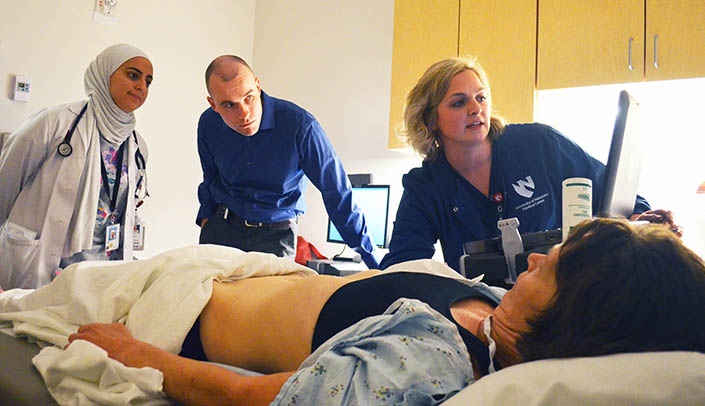Internal medicine faculty wanted to teach residents how to use point-of-care ultrasound in clinical practice.
The problem: not enough faculty have had that training themselves.
The solution?
“We have a diagnostic medical sonography program. They have a very intensive program to train sonographers. We could take advantage of their expertise,” said Christopher Smith, M.D., assistant professor of internal medicine.
So Dr. Smith went to Kim Michael, Anderson Distinguished Professor of Imaging Sciences in the College of Allied Health Professions, and associate director of the Interprofessional Academy of Educators (IAE).
Would her senior DMS students serve as “near-peer coaches”?
The IAE greenlit a pilot grant, and a handful of faculty would turn the experiment into a study, to test the idea’s effectiveness.
But first, they had to teach the teachers how to teach.
Everyone knew the sonography students knew their stuff. But, could they pass on this knowledge?
The sonography students underwent a “train the trainer” workshop.
When it came time for the training, residents spent most of a day rotating between different sonography student-coaches, practicing ultrasound skills. It was a “flipped classroom” approach.
These residents ended up scoring very well on subsequent exams.
But, because this was for research the residents and sonography students also were surveyed on the experience.
“We got quite globally-positive responses,” Dr. Smith said.
Not only did the residents score the sonography students as effective teachers – but each group gained respect for another profession and found themselves interested in pursuing future interprofessional projects.
“It really opened peoples’ eyes in working together with people of other backgrounds,” Dr. Smith said.
“I sometimes think that students who look at this as something they kind of have to do are pleasantly surprised by how much of a positive experience they have,” Michael said.
The sonography students also expressed more confidence in their own skills, post-project: “When you teach something, you really need to know it,” Michael said.
The collaborating faculty have an initial publication in BMC Medical Education, “Building a bigger tent in point-of-care ultrasound education.” But, these IAE educators also are working on the next round, to make the research more robust, and to explore the possibility of adapting to other skills and professions.
“One of big things is to disseminate information, to share with our fellow educators through the academy, and through publication,” Michael said.
“We’re looking more specifically at how it impacted the participants toward interprofessional practices in education,” Dr. Smith said.
